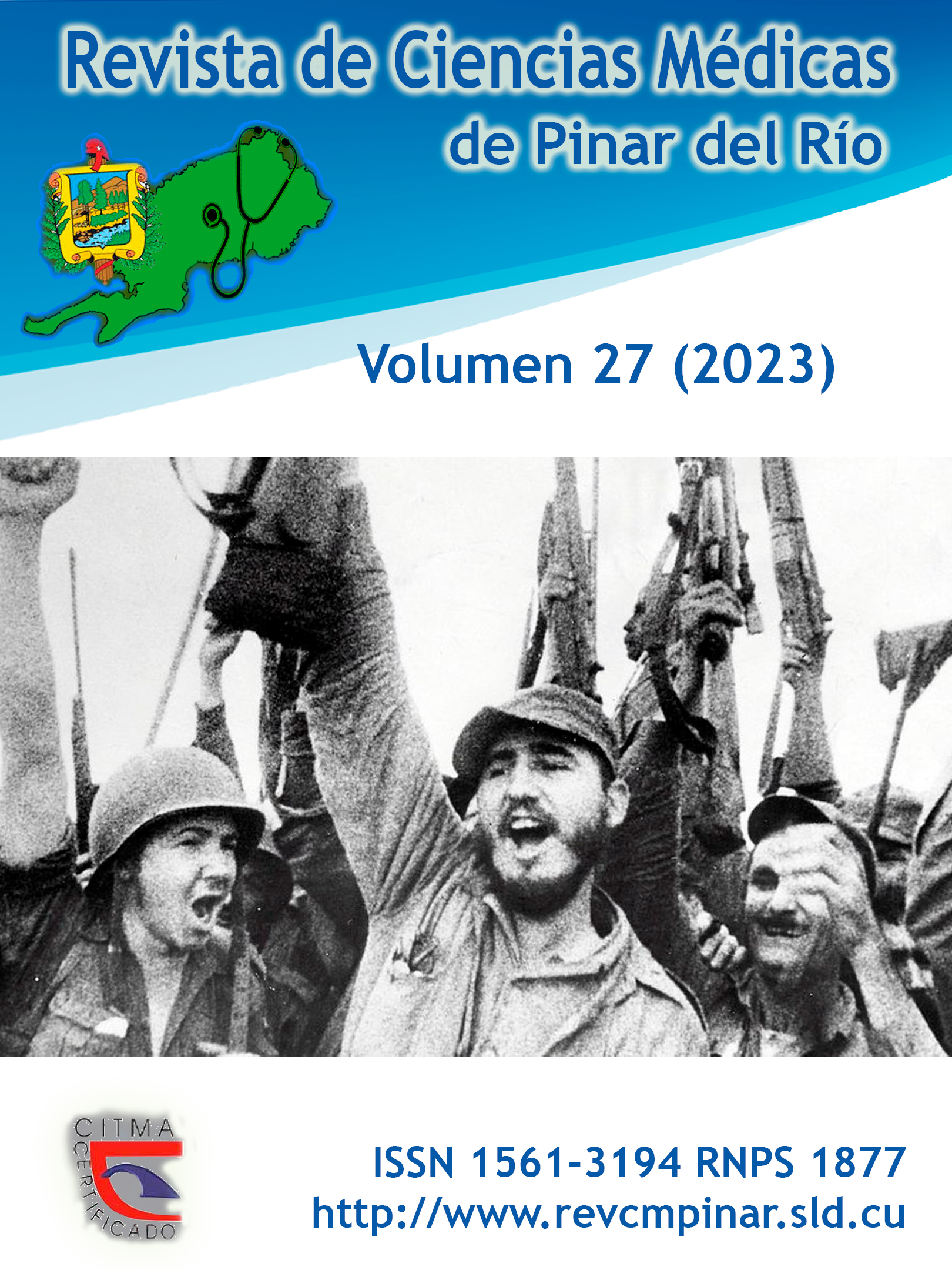The evaluation of the professional performance of the guide-interpreter for the care of deafblind people
Keywords:
EVALUATION, PERFORMANCE, GUIDE, DEAFBLIND.Abstract
Introduction: the evaluation process of the professional performance of the guide-interpreter for the care of deafblind people is a priority of the National Association of the Deaf of Cuba (ANSOC) and the National Centre for the Development of the Deaf (CENDSOR), being declared since 2016, as one of the main lines of improvement.
Objective: to design a methodology for the evaluation of the professional performance of the guide-interpreter for the care of deafblind people.
Methods: pedagogical study where theoretical, empirical and statistical methods were used, where 12 guide-interpreters, 85 cases of deafblind people in the province of Pinar del Río and eight specialists in the care of deafblind people were selected intentionally, in the period from 2018 to 2021.
Results: the study revealed the inadequacies of the evaluation of the professional performance of the guide-interpreter for the care of deafblind people in the guide-interpreter service regarding the evaluation as a process, the use of methods and techniques, dimensions and indicators for its implementation. A methodology was designed as a possible solution.
Conclusions: the evaluation of the methodology in practice confirmed its theoretical, methodological and attitudinal value, confirming higher levels in the evaluation of the professional performance of the guide-interpreter for the care of deafblind people.
Downloads
References
1. Navarro N, Falconí AV, Asanza Espinoza J. El mejoramiento del proceso de evaluación de los estudiantes de la educación básica. Revista Universidad y Sociedad [Internet]. 2017 [citado 15/07/2022]; 9(4): 58-69. Disponible en:
http://scielo.sld.cu/scielo.php?script=sci_arttext&pid=22183620&lng=es&tlng=es&
nrm=iso
2. Taype M. Definición y objetivos de la Evaluación del Desempeño [Internet].Perú: GestioPolis; 2000-2015 [actualizado 25 Nov 2015; citado 15/07/2022]. Disponible en: https://www.gestiopolis.com/definicion-y-objetivos-de-la-evaluacion-del-desempeno/.
3. Briones M Y, Peñafiel J F, Vera R Y. El Sistema de evaluación de desempeño y su aplicación como instrumento fortalecedor de los empleados de los Municipios de la Provincia de Manabí. Revista San Gregorio [Internet]. 2018 [citado 15/07/2022]; 22: 60-69. Disponible en: https://dialnet.unirioja.es/servlet/articulo?codigo=6591242
4. Rivero Y. Evaluación del desempeño: tendencias actuales. Revista Archivo Médico de Camagüey [Internet]. 2019 [citado 4 Dic 2022]; 23(2): 159-164. Disponible en:
https://revistaamc.sld.cu/index.php/amc/article/view/6141/3318
5. Santos M A. Una flecha en la diana. La evaluación como aprendizaje [Internet]. 2013 citado [4 Dic 2022]. Disponible en: https://multiblog.educacion.navarra.es/jmoreno1/files/2013/10/evaluaci%C3%B3n-de-la-escuela.pdf
6. Ramos R, Díaz AA, Valcárcel N, Ramírez BM. Las competencias profesionales específicas en la formación de los especialistas en Medicina General Integral. Educ Med Super [Internet]. 2018 [citado 04/12/2022]; 32(1): 130-140. Disponible en:http://scielo.sld.cu/scielo.php?script=sci_arttext&pid=S086421412018000100013&lng=es.
7. Unión Europea. 6 tendencias en la Evaluación de Desempeño para 2017 [Internet]. Galicia: Galejobs; 2017 [citado 04/12/2022]. Disponible en: http://www.galejobs.com/blog/2017/03/21/tendencias-2017-en-evaluacion-de-desempeno-rrhh/.
8. Martínez G, Esparza A, Gómez R. El desempeño docente desde la perspectiva de la práctica profesional.RIDE [Internet]. 2020 [citado 04/12/2022]; 11(21). Disponible en: https://doi.org/10.23913/ride.v11i21.703
9. Mujica J. Metodología para la evaluación del desempeño profesional en el acto de interpretación de los intérpretes de lengua de señas cubana [Tesis]. Instituto Pedagógico Latinoamericano y Caribeño. Centro de Referencia Latinoamericano para la Educación Especial, La Habana; 2014.
10. Quispe M. La gestión pedagógica en la mejora del desempeño docente. Investigación Valdizana [Internet]. 2020 [citado 04/12/2022]; 14(1). Disponible en: http://dx.doi.org/10.33554/riv.14.1.601
11. Zevallos M. Liderazgo transformacional del equipo de gestión y su relación con el desempeño docente en cinco instituciones educativas privadas del Perú. Revista Horizonte de la Ciencia [Internet]. 2019 [citado 04/12/2022]; 9(17). Disponible en: https://revistas.uncp.edu.pe/index.php/horizontedelaciencia/article/view/223
12. Vargas K, Borja E, Burga G, Vásquez S. Satisfacción y desempeño, en los docentes de educación primaria, en las instituciones educativas particulares del Perú, durante el periodo de la pandemia. Revista. Pol. Con [Internet]. 2020 [citado: 04/12/2022]; 5 (10): 841-867. Disponible en: https://dialnet.unirioja.es/servlet/articulo?codigo=7659418
13. Mosquera-Barrios M, González-Corrales S, Olivera-Hernández MM, Leal-Flores A, Quintana-Dovales N, Planes-Mesa Y. Caracterización del desempeño profesional de licenciados en servicios farmacéuticos en función de la atención farmacéutica. Rev Ciencias Médicas de Pinar del Río [Internet]. 2022 [citado: 04/12/2022]; 26(6): e5679. Disponible en: http://revcmpinar.sld.cu/index.php/publicaciones/article/view/5679
14. Aguilar F. El desempeño profesional docente en la educación virtual: Array. Maestro Y Sociedad [Internet]. 2022 [citado: 04/12/2022]; 19(2): 786–795. Disponible en:
https://maestroysociedad.uo.edu.cu/index.php/MyS/article/view/5565
15. De Armas N, Valle A. Resultados científicos en la investigación educativa. La Habana: Pueblo y Educación; 2011.
Downloads
Published
How to Cite
Issue
Section
License
Authors who have publications with this journal agree to the following terms: Authors will retain their copyrights and grant the journal the right of first publication of their work, which will be publication of their work, which will be simultaneously subject to the Creative Commons Attribution License (CC-BY-NC 4.0) that allows third parties to share the work as long as its author and first publication in this journal are indicated.
Authors may adopt other non-exclusive license agreements for distribution of the published version of the work (e.g.: deposit it in an institutional telematic archive or publish it in a volume). Likewise, and according to the recommendations of the Medical Sciences Editorial (ECIMED), authors must declare in each article their contribution according to the CRediT taxonomy (contributor roles). This taxonomy includes 14 roles, which can be used to represent the tasks typically performed by contributors in scientific academic production. It should be consulted in monograph) whenever initial publication in this journal is indicated. Authors are allowed and encouraged to disseminate their work through the Internet (e.g., in institutional telematic archives or on their web page) before and during the submission process, which may produce interesting exchanges and increase citations of the published work. (See The effect of open access). https://casrai.org/credit/



